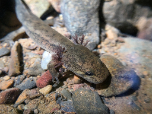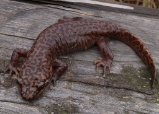California Giant Salamander (Dicamptodon ensatus)
Description: The adult California giant salamander can reach 6.7 to 12 inches in total length (including tail). Like most salamanders, the California giant salamander has four toes on the front feet and five toes on the back feet. The California giant salamander's tail is approximately 40% of the total length of the salamander and is laterally compressed. The head, back, and sides of the salamander have a marbled or reticulate pattern of dark blotches on a light brown or brassy-colored background. They have a broad head with a shovel-like snout and a fold of skin across the throat called the gular fold. The eyes are medium in size and have a brass-flecked iris and a large black pupil. This species is one of the few salamanders capable of vocalizing.
California giant salamanders are preyed upon by the American water shrew (Sorex palustris) and the Aquatic Garter Snake (Thamnophis atratus).
Some California giant salamander larvae continue to grow into adults and become sexually mature without losing their external gills. This process is called neoteny. Adult-sized neotenes have a uniform brown coloring on their heads, sides, and backs and retained external gills which allow them to live in perennial streams as aquatic adults.
Habitat: The natural habitats of D. ensatus are damp temperate forests and clear, cold freshwater streams, ponds, and lakes.
Range: The California giant salamander is endemic to Northern California and lives up to 6,500 feet primarily in damp, coastal forests including coast Douglas fir (Pseudotsuga menziesii var. menziesii) and California coast redwood (Sequoia sempervirens) in both montane and valley-foothill riparian habitats. They tend to be common where they occur. The adult terrestrial form is found under surface litter and in tunnels, while the adult aquatic and larval forms are found mainly in cool, rocky streams and occasionally in lakes and ponds.
It is found in two (possibly three) isolated regions. The first range includes Sonoma, Napa, and Marin Counties, southwestern Lake County, western Glenn County, and southern Mendocino County. The other documented region is south of the San Francisco Bay from central San Mateo County to southern Santa Cruz County plus western Santa Clara County. The California giant salamander does not occur in the East Bay, forming a gap between these two populations. There is an unconfirmed sight record from Big Sur in Monterey County, approximately 75 miles to the south of the documented population in the Santa Cruz area.
Found in these States:
CA
Diet:
Terrestrial adults search for prey such as snails, slugs, insects (such as beetles, caddisfly larvae, moths, and flies), other invertebrates, small mice (such as white-footed mice), shrews, possibly reptiles, and other amphibians under surface objects and in tunnels. Aquatic adults and larvae eat aquatic invertebrates, fish, snakes, and other amphibians.
Reproduction: The California giant salamander breeds from March to May, with egg-laying peaking in May. Eggs are concealed several feet below the surface in cold, slowly flowing water often beneath rocks and coarse woody debris in stream bottoms. Adults sometimes stay near their nests. Larvae may lose their external gills and transform to terrestrial adults after 1 to 2 years. In permanently perennial streams, adults may retain their gills and become aquatic adults
Status: Listed as Near Threatened because its extent of occurrence (EOO) is 27,830 km2, it likely occurs in ten or fewer threat-defined locations, and there is continuing decline in the extent and quality of its habitat, thus making the species close to qualifying for Vulnerable.
»» Kingdom: Animalia - Animals
»» Phylum: Chordata - Chordates
»» Subphylum: Vertebrata - Vertebrates
»» Class: Amphibia - (Amphibians)
»» Order: Caudata - Salamanders
»» Family: Salamandridae - Newts
»» Subfamily: Pleurodelinae - Pleurodeline Newts
»» Genus: Dicamptodon
»» Species: Dicamptodon ensatus - California Giant Salamander
This article uses material from the Wikipedia article "California Giant Salamander", which is released under the Creative Commons Attribution-Share-Alike License 3.0. Content may have been omitted from the original, but no content has been changed or extended.
|













